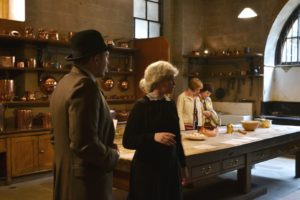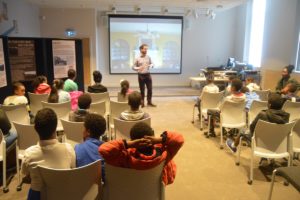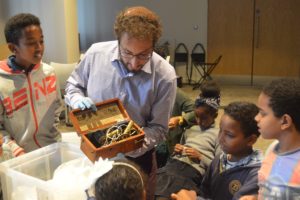*Update: please see the Harewood House category for other posts about this project.*
After the success of our first workshop, which you can read about here, on Sunday 21 August we had a day of history of electricity themed fun at Harewood House, as part of which we unveiled our new history of lighting displays. With one Below Stairs and one on the State Floor, these new displays and their accompanying interpretation were based on the results of our research in the Harewood archives and in the West Yorkshire Archives.
The Below Stairs lighting cabinet now tells the story of how electricity came to Harewood House – including how the original electrical installation was powered by a hydroelectric turbine. In addition it exhibits the only physical evidence we have found of the gas lighting which would have been used below stairs between the 1860s and the installation of electricity: two gas burners. Also featured is a copy of the original electric lighting specification for the house, from 1901, which shows how comprehensive the system was: even the servants’ bedrooms and toilets were to have electric lights. However, candlesticks and oil lamps dating from the 1930s and 40s also demonstrate that older technologies were still used to supplement electricity, either as back-ups in case of power-cuts, or perhaps because the softer, gentler light of the flickering flames was sometimes preferred.

The temporary display upstairs in Princess Mary’s Dressing Room contains the original plans for the room as it was designed in 1930, including the lighting. Also displayed is a portion of a letter from Princess Mary to her architect Sir Herbert Baker in which she requested electric lighting for the glass-fronted cupboards in which she wished to keep her collection of amber and jade; she noted that the amber “is translucent and is very pretty when lit with electric light.”

We began our day of activities with a short talk given by Collections Assistant Rebecca Burton about the research we had done, inviting people to see the new displays and also to attend our workshop scheduled for the afternoon. Using documents from the archives Rebecca went through the story of Harewood’s electrification, from the first electric lights in 1901 to the installation of appliances like television – and an ice cream cabinet! – in the 1950s.

Visitors also had the chance to engage in electricity-themed arts and crafts: making and decorating cup and string telephones – an activity popular with adults as well as with children! We believe that telephones were probably installed in the house before electric lights, and telephones featured in our workshop as during the 1930s, when the workshop performance was set, the family installed an automatic internal telephone system in the house. It was also at this time, in 1933, that the local telephone exchange switched from manual to automatic, prompting the Post Office to send a representative to the house to explain how to use the new system.

Before the workshop, our three actors walked around the house in costume interacting with visitors in character: Mrs Merton, the housekeeper, was showing Mr Symes, the electrician, around to look at the electrical systems, and Betty the maid was trying to stay out of their way! This provided a fun way to draw attention to the workshop and introduce the characters.

The workshop itself followed the same structure as the one we ran for IntoUniversity students a few weeks earlier, which you can read more about here, beginning with a performance – in the authentic environment of the Steward’s Room – about the modernisation of the house in the 1930s by the 6th Earl and Princess Mary, and followed by an opportunity for the audience to ask questions of the characters.


As before, we then introduced the children to old electrical objects from Artemis, the Leeds Museums and Galleries object loan service, which were again very popular, with kids noting how heavy things like the 1930s vacuum cleaner and the kettle were compared with their modern equivalents, and also how different old plugs looked compared with the ones we’re familiar with today.

As well as these activities the children also had the opportunity to do an electricity trail, which encouraged them to seek out various electrical and other lighting-related artefacts placed around the Below Stairs area of the house. We were very pleased with how our various activities were received; we had a full house for the workshop, and the crafts activity was consistently well attended. In focusing on electricity for a day we’ve certainly provided something new for visitors, and successfully launched our newly researched interpretative materials.
Our final workshop for this project will be held at the University on Sunday 11 September as part of Heritage Open Days.









